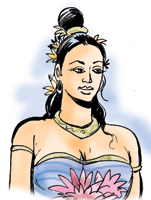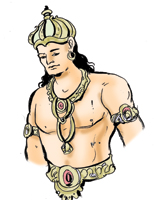1. The details relating to the early life of Parakramabahu VI, that are available locally, are not quite clear. There are a few descriptions in the Chinese sources too. All that relates to the fact that the Chinese emperor
nominated him and he came to power, with the help of Cheng-ha. According to these sources, it goes like this – In the Chinese court, at the request of the Chinese emperor, the Sinhala
people who were present there, selected
'Yeh-pa-ne-na.' This person was later named as 'Pu-la-co-ma-ba-se-la-va.'
2. Some believe that this would have been no other name than Parakramabahu VI, in the Chinese language. However, Chinese records mention that Parakramabahu VI,
personally carried gifts to the Chinese emperor. This has been during the years 1416 and 1421. Going by our records, during this time, there was no other Parakramabahu, other than this king. There are other records which say that Parakramabahu was not a prisoner, while he was a prince.
3. However, he has been depending on
Cheng-ha's support. This happened because, the line of Veera-Alakeshwara rulers were enemies of the prince. In the Sinhala court then, this prince had not been present. In the first visit of Cheng-ha, this prince had gone to China, while still a child. Long before Veera-Alakeshwara took him captive, the Sinhala people of the low country, were supportive of this prince.
4. In analyzing these historical details, we notice, that some are
contradictory. In one place, it is said that the rebellion in Kandy, which arose during the time of this prince, was
suppressed by 'Menavara Thunaya.' He is the nephew of 'Parakramabahu Epa' of Dodanwela. There is
evidence to show, however, that the Kandyans were pardoned this time. This is recorded in a pillar inscription in Gadaladeniya.
5. By this time, King Parakrambahu had been king for about five years. In the Gadaladeniya pillar inscription, this name is given as Jayaweera Parakramabahu. By this time, the line of Gampola kings, had become weak and they had surrendered to King Parakramabahu. He had permitted one belonging to that line, to remain under the name Kumara – to preserve their dignity.
6. In the records of King Parakramabahu VI's time, years are counted in the 'Buddha' or 'Saka' era. Accordingly, the year he returned from China is determined as 1412 AD. After defeating the
enemies, he had ascended the throne as king, only in 1415 AD. He has been crowned in Raigama. So he had stayed there, for about three years and then come to Kotte.
7. A new palace was built in Jayawardane-pura Kotte. A 'Temple of the Tooth' was also
constructed. This king's queen had been a princess from Keerawella. Although her name is not mentioned, her daughter's name is given. She was Lokanatha – also called 'Ulakudayadevi.' This king's 'Yuvaraja' was his younger brother, who lived in the city of 'Mayadunu.'
8. Scholars believe this to be Ambulugala in the Four Korale. Once King Parakramabahu VI unified the country under one banner, he ignored the Chinese. He was no more interested in maintaining any friendly relations and no tribute was sent. It is said, that this prompted Cheng-ha to come to Lanka. Anyway, even in the Chinese sources, the envoys who went to China, are not mentioned clearly. |



